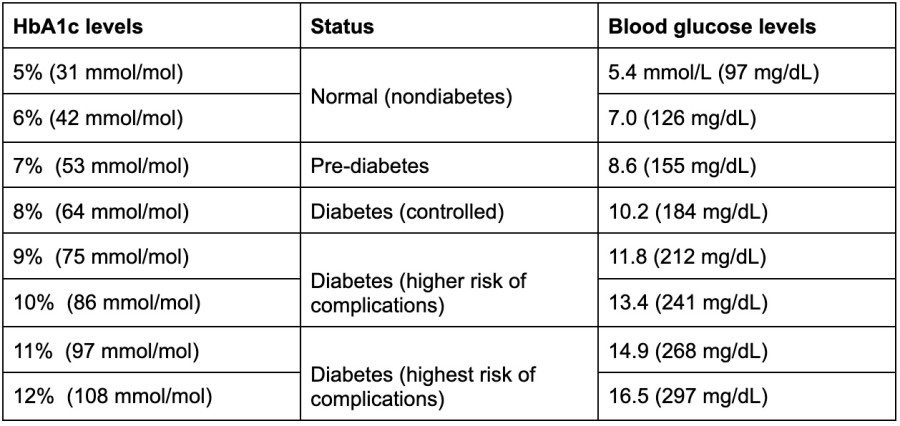A Guide To HbA1c: About The HbA1c Test

A Guide To HbA1c: About The HbA1c Test
HbA1c stands for “glycated haemoglobin,” an important marker of blood glucose levels and long-term blood glucose trends.
Measuring HbA1c levels can help diagnose diabetes and prediabetes. If you have already been diagnosed with diabetes, an HbA1c test can also help you and your healthcare team manage the condition by looking at trends over previous months.
In this guide, we take a closer look at what HbA1c testing is, how to undergo an HbA1c test, why it is necessary to measure HbA1c levels, and the differences between HbA1c testing and other forms of blood glucose level monitoring.
What is HbA1c?
The HbA1c test is also known as the A1C test, the glycated haemoglobin test, or the haemoglobin A1c test.
It measures “glycated haemoglobin” — that is, haemoglobin that is “coated” with glucose from the bloodstream.
Once glucose is obtained from food and enters the bloodstream, it attaches to haemoglobin — the protein that gives blood its bright red colour and whose main role is to carry oxygen from the lungs to all the cells in our body.
This glycation process is normal, and as a result of it, everyone has some glucose attached to their haemoglobin.
Higher blood glucose levels show on the surface of the haemoglobin protein. The HbA1c test measures the percentage of your red blood cells that have glucose-coated haemoglobin.
The higher the percentage, the more glucose you are likely to have in your blood.
What is a HbA1c test?
The HbA1c blood test is used to determine whether a person’s average blood glucose levels are within the ‘normal’ range (which is where ‘nondiabetes’ falls) or within the target range, for the treatment and management of diabetes. The test shows an average of the blood glucose level over the past 90 days.
The HbA1c test can be done either at a point of care (i.e. at home, at a pharmacy, at a general medical practice, in a hospital, etc), or be sent to a lab.
The test requires no special preparation, such as fasting. It involves drawing a blood sample from a capillary using a fingerstick (or fingerprick), or it can be taken from your arm.
All healthcare professionals who care for a person with diabetes should be able to fully understand and interpret an HbA1c test.
HbA1c levels: What is the expected HbA1c range?
HbA1c test results will usually fall within the following ranges [1]:
- 4.0%–5.6%: common range, or non-diabetes
- 5.7%–6.4%: prediabetes
- 6.5% or higher: diabetes
If you have prediabetes, the higher your HbA1c levels, the higher your risk of developing type 2 diabetes [3].
Generally, if you have type 2 diabetes, your healthcare team may recommend you maintain HbA1c levels below 7%, along with leading a balanced diet and lifestyle.
However, various factors may come into play that will determine your personalised HbA1c goals. For example, people who have frequent hypoglycaemia, who have already developed severe complications, or whose diabetes is long-standing, may have this target increased.
By contrast, a target of below 6.5% may be set for people:
- whose diabetes onset is quite recent,
- who have type 2 diabetes that is being treated only with lifestyle modifications or only with metformin
- who have no significant cardiovascular disease, no other complications or conditions
For type 1 diabetes, the risk of hypoglycaemia is greater, so setting a lower limit of HbA1c comes with more risks. Although different countries and international organisations have not reached a consensus on the threshold that helps avoid complications, it is generally recommended that HbA1c levels stay between 6.5 and 7.5%.
Some new research, however, suggests the risk of complications can be kept to a minimum in type 1 diabetes by maintaining an HbA1c ‘sweet spot’ between 6.5% and 6.9% .
The benefits of achieving HbA1c targets
HbA1c tests can predict and avoid chronic hyperglycaemia — or high levels of blood glucose — which can help to reduce the risk of long-term complications.
Numerous studies have shown that hitting HbA1c targets reduces the risk of developing microvascular complications such as retinopathy, neuropathy, and kidney disease in both type 1 and type 2 diabetes.
The risk of heart attacks, stroke and cardiovascular disease is also lower with well-managed glycaemic levels, particularly in the long term.
How often should HbA1c be checked?
A1C testing should be performed routinely in all patients with diabetes, from initial assessment and then as part of continuing diabetes care.
As soon as diabetes is diagnosed, HbA1c should be monitored approximately every three months to determine whether glycaemic targets have been reached and maintained.
For people with type 1 diabetes, the World Health Organization (WHO) recommends more frequent monitoring than the twice-a-year frequency recommended for type 2.
The difference between HbA1c testing and blood glucose monitoring
Both HbA1c testing and blood glucose monitoring can be used to measure blood glucose levels, but there are differences between the two types of tests.
The HbA1c test can provide a reading of how glucose levels average over a period of 2–3 months, whereas blood glucose level tests give you a reading at a particular point in time.
So, blood glucose monitoring can capture short-term variations in your blood glucose, which the HbA1c test cannot do. For example, two people may have the same HbA1c readings, but one of them may experience spikes and drops in blood glucose.
Being able to see how your blood glucose fluctuates throughout the day, and which activities or foods affect it, can help you make immediate treatment decisions, like administering insulin. It can also help you avoid episodes of hyperglycaemia (high glucose levels) or hypoglycaemia (low glucose levels).
Diabetes complications
On the other hand, the HbA1c test correlates well with the risk of diabetes complications in the long term, so it is a great way to monitor and manage a condition like diabetes.
Some research has suggested that the HbA1c test is more accurate than blood glucose monitoring at predicting the risk of retinopathy, stroke, heart disease, and all-cause mortality. However, the WHO cautions that the evidence here remains unclear.
Diagnosing diabetes
For diagnosing diabetes, the HbA1c test is more convenient. You do not need to be in a fasting state when you take the test, as is the case with the fasting plasma glucose test or the oral glucose tolerance test (OGTT).
However, there are certain factors that can make the HbA1c less accurate, such as genetic factors or some illnesses like malaria or some anaemias. It is worth noting too, that while HbA1c tests are useful and convenient compared with measures of plasma glucose for the diagnosis of diabetes, HbA1c tests are unavailable in many countries.
The WHO also caution that a single HbA1c test is not enough to make a diagnosis of diabetes and that more research in all major ethnic groups is needed to determine if HbA1c levels accurately predict complications from diabetes.
Hba1c conversion chart
According to Sherwani et al. (2016), the following conversion chart shows how HbA1c levels correlate with average blood glucose levels and risk of diabetes and diabetes-related complications:

The HbA1c blood test is a cornerstone of diabetes diagnosis and management.
Overall, testing glycated haemoglobin is a convenient and accurate way of measuring blood glucose levels, and the HbA1c range is key for establishing the risk of diabetes and diabetes-related complications.
Sources
- Sherwani, S. I., Khan, H. A., Ekhzaimy, A., Masood, A., & Sakharkar, M. K. “Significance of HbA1c test in diagnosis and prognosis of diabetic patients.” Biomarker Insights 2016:11 95–104 doi: 10.4137/BMI.S38440. https://journals.sagepub.com/doi/pdf/10.4137/BMI.S38440
- Eyth, E., & Naik, R. “Hemoglobin A1C.” [Updated 2021 Apr 5]. In: StatPearls [Internet]. Treasure Island (FL): StatPearls Publishing; 2022 Jan-. https://www.ncbi.nlm.nih.gov/books/NBK549816/
- “All About Your A1C.” Centers for Disease Control and Prevention (CDC). Accessed March 3, 2022. https://www.cdc.gov/diabetes/managing/managing-blood-sugar/a1c.html
- “Definitions: Point of Care testing.” Department of Health, Australian Government. Accessed March 3, 2022. https://www1.health.gov.au/internet/publications/publishing.nsf/Content/qupp-review~qupp-definitions
- “Diabetes: Type 2 diabetes management.” World Health Organization (WHO) Package of Essential Noncommunicable Diseases (PEN). https://www.who.int/ncds/management/2.2_DIABETES_Type_2_management-WHOPEN.pdf
- ARG, T. “Glycemic Targets: Standards of Medical Care in Diabetes—2018.” American Diabetes Association, Diabetes Care 1 January 2018; 41 (Supplement_1): S55–S64. https://doi.org/10.2337/dc18-S006
- Lind M, Pivodic A, Svensson A, Ólafsdóttir A F, Wedel H, Ludvigsson J et al. “HbA1c level as a risk factor for retinopathy and nephropathy in children and adults with type 1 diabetes: Swedish population based cohort study.” BMJ 2019; 366:l4894 doi:10.1136/bmj.l4894 https://www.bmj.com/content/366/bmj.l4894
- “Global report on diabetes.” World Health Organization, 2016. https://www.who.int/publications/i/item/9789241565257
- “Use of Glycated Haemoglobin (HbA1c) in the Diagnosis of Diabetes Mellitus: Abbreviated Report of a WHO Consultation.” (No. WHO/NMH/CHP/CPM/11.1). World Health Organization, 2011. https://www.who.int/diabetes/publications/report-hba1c_2011.pdf
- Johns Hopkins University Bloomberg School of Public Health. "Hemoglobin A1c outperforms fasting glucose for risk prediction." ScienceDaily. ScienceDaily, 10 March 2010. https://www.sciencedaily.com/releases/2010/03/100303192434.htm





